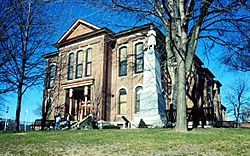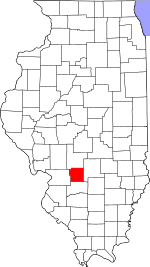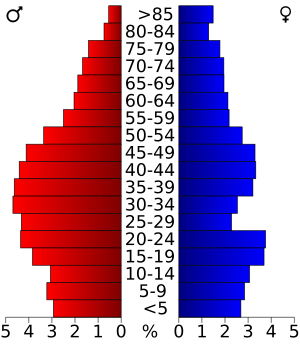Bond County, Illinois facts for kids
Quick facts for kids
Bond County
|
|
|---|---|

Bond County Courthouse in Greenville
|
|

Location within the U.S. state of Illinois
|
|
 Illinois's location within the U.S. |
|
| Country | |
| State | |
| Founded | 1817 |
| Named for | Shadrach Bond |
| Seat | Greenville |
| Largest city | Greenville |
| Area | |
| • Total | 383 sq mi (990 km2) |
| • Land | 380 sq mi (1,000 km2) |
| • Water | 2.5 sq mi (6 km2) 0.6% |
| Population
(2020)
|
|
| • Total | 16,725 |
| • Density | 43.67/sq mi (16.860/km2) |
| Time zone | UTC−6 (Central) |
| • Summer (DST) | UTC−5 (CDT) |
| Congressional district | 15th |
| Website | https://www.bondcountyil.com/ |
Bond County is a county in the state of Illinois, USA. In 2020, about 16,725 people lived here. The main town and county seat (where the county government is) is Greenville.
Bond County is part of the larger St. Louis, MO-IL area, which is a big group of cities and towns.
Contents
History of Bond County
Bond County was created in 1817 from Madison County. It was named after Shadrach Bond. He was a representative for the Illinois Territory in the US Congress. Later, he became the very first governor of Illinois, serving from 1818 to 1822.
The main city in the county, Greenville, got its first post office in 1819. It became an official town in 1855 and a city in 1872. People have different ideas about how Greenville got its name. Some think it was named after Greenville, North Carolina. That town was named after a general from the American Revolutionary War, Nathanael Greene. Others say an early settler named Thomas White called it "so green and nice." Another idea is that it was named after Green P. Rice, who was the town's first merchant.
In 1824, people in Bond County voted on whether to allow slavery. Most people, 240 of them, voted against it. Only 63 voted for it. Even though Illinois was a free state, it was next to states where slavery was allowed, like Missouri and Kentucky. Illinois did allow something called "indentured servants." This was a way some slave owners kept people working for them, even in a free state.
In Bond County, 14 people were listed as indentured servants to eight different owners at one time. One person, Silas Register, even took his last name from being registered at the county clerk's office. Silas Register was the last known indentured servant in Bond County to live there. He passed away in 1872 when he was 76 years old. Some of these former indentured servants are buried in the county with the families they worked for. One woman, Fanny, became free after her owners moved away. She worked hard in town to earn money. She then bought her husband, Stephen, at an auction in Missouri to free him.
During the 1840s, Bond County was a stop on the Underground Railroad. This was a secret network that helped people escape slavery and find freedom. A teacher named T.A. Jones lived in Reno. In 2008, a letter from him was found. In the letter, he talked about his work with the Underground Railroad. People escaping slavery often came from Missouri. They sometimes traveled through Carlyle to reach Bond County. Rev. John Leeper was able to hide his Underground Railroad work because he also ran a milling business. Dr. Henry Perrine was a doctor near Greenville and helped with the secret railroad activities. In the 1930s, a secret room was found in Rev. George Denny's house. This room had been used by the Underground Railroad.
Greenville University started as Almira College in 1855. In 1941, the college president said that both Almira College and Greenville were founded on prayer.
In 1858, Abraham Lincoln and Stephen Douglas gave speeches in Greenville. They were running for the United States Senate. Douglas said he was very happy to see so many people gathered to hear him on his first visit to Bond County. A newspaper, Illinois State Register, wrote that they had never seen such a large gathering in Bond County before.
Women in Bond County were able to vote for the first time in 1914. On November 21, 1915, the famous Liberty Bell traveled through Greenville. It was on a trip across the country, returning to Pennsylvania from an event in San Francisco. After that trip, the Liberty Bell went back to Pennsylvania and has not been moved since.
The Greenville Public Library was built with money from Andrew Carnegie. It is now on the National Register of Historic Places, which means it's a special historical building.
During the Great Depression in 1934, about 500 people protested in Greenville. They marched to the Illinois Emergency Relief Commission. They wanted to complain about how emergency supplies were being given out by the state and federal governments.
Ronald Reagan visited Greenville in the 1980s when he was campaigning to become president. He gave a speech on the courthouse lawn. Barack Obama, who was a senator from Illinois at the time, also visited Greenville in 2004. He was campaigning for his Senate seat.
Geography of Bond County
The U.S. Census Bureau says that Bond County covers about 383 square miles. Most of this, about 380 square miles, is land. The rest, about 2.5 square miles (0.6%), is water.
Neighboring Counties
- Montgomery County – to the north
- Fayette County – to the east
- Clinton County – to the south
- Madison County – to the west
Main Roads
 Interstate 70
Interstate 70 U.S. Route 40
U.S. Route 40 Illinois Route 127
Illinois Route 127 Illinois Route 140
Illinois Route 140 Illinois Route 143
Illinois Route 143
Climate and Weather
| Weather chart for Greenville, Illinois | |||||||||||||||||||||||||||||||||||||||||||||||
|---|---|---|---|---|---|---|---|---|---|---|---|---|---|---|---|---|---|---|---|---|---|---|---|---|---|---|---|---|---|---|---|---|---|---|---|---|---|---|---|---|---|---|---|---|---|---|---|
| J | F | M | A | M | J | J | A | S | O | N | D | ||||||||||||||||||||||||||||||||||||
|
2.2
37
21
|
2
44
26
|
3.6
56
35
|
4.2
68
45
|
4.3
78
55
|
4.1
87
64
|
3.5
91
68
|
3.5
89
66
|
3.2
82
58
|
2.9
71
47
|
3.8
55
37
|
3
42
26
|
||||||||||||||||||||||||||||||||||||
| temperatures in °F precipitation totals in inches source: The Weather Channel |
|||||||||||||||||||||||||||||||||||||||||||||||
|
Metric conversion
|
|||||||||||||||||||||||||||||||||||||||||||||||
In Greenville, the county seat, average temperatures are around 21 degrees Fahrenheit in January. In July, they can reach about 91 degrees Fahrenheit. The coldest temperature ever recorded was -22 degrees Fahrenheit in February 1905. The hottest was 114 degrees Fahrenheit in July 1954. The county usually gets about 2 to 4.3 inches of rain or snow each month. May is usually the wettest month.
People of Bond County (Demographics)
| Historical population | |||
|---|---|---|---|
| Census | Pop. | %± | |
| 1820 | 2,931 | — | |
| 1830 | 3,124 | 6.6% | |
| 1840 | 5,060 | 62.0% | |
| 1850 | 6,144 | 21.4% | |
| 1860 | 9,815 | 59.7% | |
| 1870 | 13,152 | 34.0% | |
| 1880 | 14,866 | 13.0% | |
| 1890 | 14,550 | −2.1% | |
| 1900 | 16,078 | 10.5% | |
| 1910 | 17,075 | 6.2% | |
| 1920 | 16,045 | −6.0% | |
| 1930 | 14,406 | −10.2% | |
| 1940 | 14,540 | 0.9% | |
| 1950 | 14,157 | −2.6% | |
| 1960 | 14,060 | −0.7% | |
| 1970 | 14,012 | −0.3% | |
| 1980 | 16,224 | 15.8% | |
| 1990 | 14,991 | −7.6% | |
| 2000 | 17,633 | 17.6% | |
| 2010 | 17,768 | 0.8% | |
| 2020 | 16,725 | −5.9% | |
| 2023 (est.) | 16,450 | −7.4% | |
| U.S. Decennial Census 1790-1960 1900-1990 1990-2000 2010-2013 |
|||
In 2020, there were 16,725 people living in Bond County. There were 6,359 households and 4,033 families. The county had about 43.7 people per square mile. Most people (86.4%) were white. About 6.4% were black or African American. People of Hispanic or Latino background made up 3.6% of the population. The most common backgrounds reported were German (28.9%), Irish (13.4%), and English (9.3%).
About 25.6% of households had children under 18 living with them. The average household had 2.32 people. The average family had 2.87 people.
The median age in the county was 42.5 years old. This means half the people were older than 42.5 and half were younger. For every 100 females, there were about 111 males.
The median income for a household was $53,568. This means half of the households earned more than this, and half earned less. About 13.6% of all people in the county lived below the poverty line. This included 17.0% of those under 18 years old.
When it comes to education, 33.2% of people had finished high school or an equivalent degree. About 13.2% had a bachelor's degree from college.
2020 Census Racial Makeup
| Race | Num. | Perc. |
|---|---|---|
| White (Not Hispanic) | 14,264 | 85.28% |
| Black or African American (Not Hispanic) | 1,073 | 6.4% |
| Native American (Not Hispanic) | 52 | 0.31% |
| Asian (Not Hispanic) | 94 | 0.56% |
| Pacific Islander (Not Hispanic) | 11 | 0.06% |
| Other/Mixed (Not Hispanic) | 627 | 3.75% |
| Hispanic or Latino | 604 | 3.61% |
Education in Bond County
Here are some of the school districts and colleges in or serving Bond County:
- Bond County Community Unit School District 2
- Carlyle Community Unit School District 1
- Highland Community Unit School District 5
- Hillsboro Community Unit School District 3
- Mulberry Grove Community Unit School District 1
- Vandalia Community Unit School District 203
- Greenville University
Communities in Bond County
| Community |
Community type |
Population | Total Area |
Water Area |
Land Area |
Pop. Density |
|
|---|---|---|---|---|---|---|---|
| Donnellson | village | 153 | 0.37 | 0.00 | 0.37 | 413.51 | |
| Greenville | city | 7,083 | 6.31 | 0.00 | 6.31 | 1,122.68 | |
| Keyesport | village | 406 | 0.74 | 0.02 | 0.72 | 563.89 | |
| Mulberry Grove | village | 520 | 1.02 | 0.01 | 1.02 | 511.81 | |
| Old Ripley | village | 82 | 0.15 | 0.00 | 0.15 | 532.47 | |
| Panama | village | 337 | 0.37 | 0.00 | 0.36 | 923.29 | |
| Pierron | village | 459 | 0.73 | 0.00 | 0.73 | 630 | |
| Pocahontas | village | 697 | 0.80 | 0.02 | 0.78 | 890.17 | |
| Smithboro | village | 154 | 0.93 | 0.00 | 0.93 | 165.24 | |
| Sorento | village | 429 | 0.80 | 0.00 | 0.80 | 537.59 | |
| Bond County | county | 16,725 | 383 | 2.5 | 380 | 44 |
Townships
Bond County is divided into these nine areas called townships:
- Burgess
- Central
- Lagrange
- Mills
- Mulberry Grove
- Old Ripley
- Pleasant Mound
- Shoal Creek
- Tamalco
Unincorporated Communities
These are smaller communities that are not officially part of a city or village:
- Ayers
- Beaver Creek
- Bunje
- Dudleyville
- Durley
- Gilmore
- Hamburg
- Hookdale
- Keyesport Landing
- Paisley Corners
- Pleasant Mound
- Reno
- Stubblefield
- Tamalco
- Woburn
See also
 In Spanish: Condado de Bond para niños
In Spanish: Condado de Bond para niños






